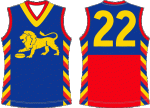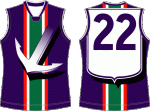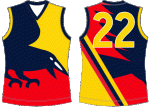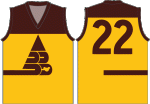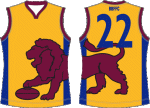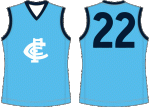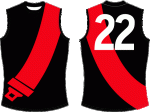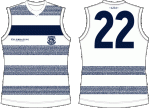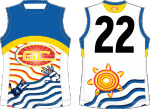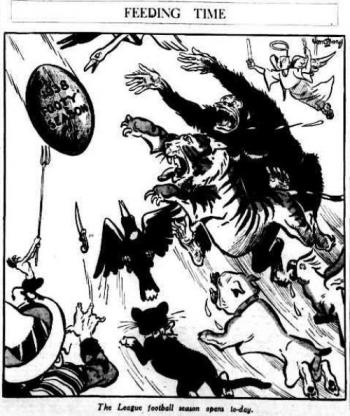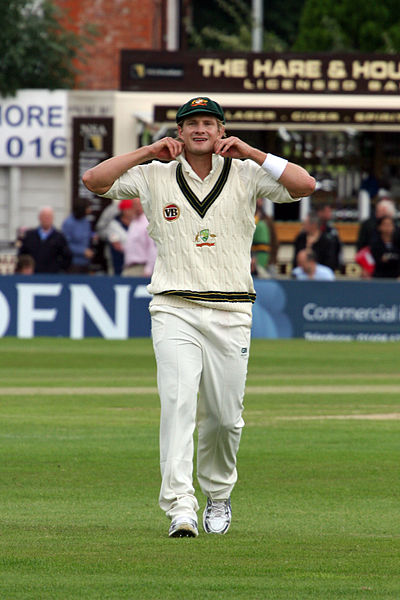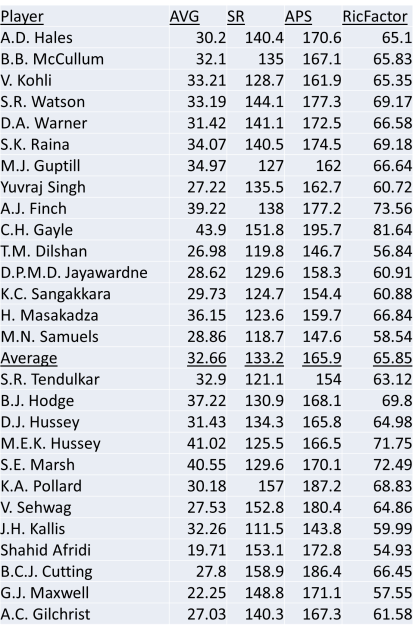Welcome back. After wasting 3,000 words of your time on part one, it’s good to have you back. We’ll quickly go over some rules here, trust me it will be briefer than part one. Which, if you haven’t read, you can do so right here. Each team will have a judgment over their best and worst home jumper and best and worst away jumper. Away jumpers include clash jumpers. Just because I’m kind, I’ll throw in a section about special jumpers, promotional, Indigenous and others. Every single jumper wont be mentioned, while I’m wasting a lot of time on this, I’m not willing to waste all my time. University doesn’t get a section in here, but South Melbourne is split from Sydney Swans. No State of Origin teams, or International Rules, but who knows, maybe in the future. Also, I know Footscray/Western Bulldogs should have come before Gold Coast alphabetically, but I didn’t think of that one week ago. As always, this is all just my opinion. If you have any issues, feel free to comment them at the bottom, or attack me on Twitter. Basically all of this info is drawn from footyjumpers.com. It’s a great site.
Footscray/Western Bulldogs
Best home: The Footscray jumper is a great, traditional, home spun look. There is nothing wrong  with the current jumper at all. The hoops were lowered slightly in 2015 so the number rests neatly on top of the hoop, and it is a great touch. The older jumpers were fine as well, there are a lot of years of quality jumpers here without change that look great. The hoops got put together a few times, and in 1975 Footscray changed the hoops into a red hoop with white outlines, and even that looked good. Give the best to the 1946 onwards jumper (officially the Bulldogs wore it 1946-50 and 1952-69), just because of the old style collars.
with the current jumper at all. The hoops were lowered slightly in 2015 so the number rests neatly on top of the hoop, and it is a great touch. The older jumpers were fine as well, there are a lot of years of quality jumpers here without change that look great. The hoops got put together a few times, and in 1975 Footscray changed the hoops into a red hoop with white outlines, and even that looked good. Give the best to the 1946 onwards jumper (officially the Bulldogs wore it 1946-50 and 1952-69), just because of the old style collars.
Worst home: Look, the Bulldog silhouette on the jumper wasn’t a great look. It was a downgrade from the other jumper, there is no doubt, but the Western Bulldogs need to do anything they can to create a brand and bring in money, so it makes a little sense, and it still was an ok-ish jumper. It’s not the worst though. Despite a strange decision to switch from royal blue to navy in 1944-45, the honour of the worst goes to the 1935 jumper. This is a horror. A clown outfit, with veritcal stripes and a bad white vee. Apparently, the jumpers were all destroyed after the 1935 season when they were dry-cleaned and thank goodness for that.
Edit: While the jumper still isn’t perfect, it looks great in this painting tweeted to me.
Best away: The Dogs have tried a few away jumpers, While the newer red backed reversal of the home jumper is alright, the white backed is the best one. It’s a good clash jumper, and a solid reversal, while not being as garish as the red back.
Worst away: The Dogs tried wearing a pre-season jumper during 1995-96 that was trying too hard, but the worst was an Origin Energy jumper from 2005 that took the company logo and made a jumper out of it. Not a good look.
Specials: The 2003 heritage jumper was a reworking of the 1935 version, taking out the vee to make it more bearable, but it still didn’t look great. Their Indigenous jumper wasn’t too bad, the little drawing of a footy field on the front was a little unnecessary though. The Dogs tried a couple of pre-season jumpers, a white backed one in 1979 and a blue backed in 1980 with coloured lines on the left side of the player. They would be pretty good jumpers for a TAC Cup team to wear, actually. The 1999-00 pre-season jumper was the same as the home, but removing the red hoop in favour of a red fill on the top third of the jumper and it wasn’t too bad, the follow up in 2002 took it a step further by creating a larger white outline over the bulldog logo, which was unnecessary. This year, the Dogs introduced a Ballarat jumper, with a star-flag type design (likely taken from the Eureka Flag) and a cartoon Bulldog. The flag design is a nice touch for Ballarat, but cartoon animals don’t really belong on jumpers.
Greater Western Sydney Giants
Best home jumper: We aren’t starting with anything special here. GWS have altered their collars three times and that is all. I’m more of a fan of the V style collar, so the inaugural jumper wins. 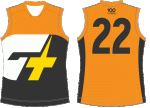
Worst home jumper: The latest jumper has a difficult collar. It has a flap on the below half of the V, and from experience that flat can be a bit restrictive.
Best away jumper: In 2014 the Giants altered their away jumper to add a charcoal strip to the jumper, as a homage to the home jumper. It looks nice, and it isn’t plain like the original version.
Worst away jumper: The original jumper is quite dull. There is just G in the centre and that is really about it.
Special jumpers: The Giants have had a few variants in the specials category. In 2013, as a celebration of Kevin Sheedy‘s last game as head coach, the Giants had a little paragraph about him on their jumper. Outside that, their Canberra jumper features a cross on it, perhaps hailing Tony Abbott as the messiah. It’s not a bad touch. In 2013 they changed the cross to gold to celebrate 100 years of Canberra, which also was a adaptation look.
Hawthorn Hawks
Best home: Brown and gold is a difficult combination to pull off, and the vertical stripes are pretty gross. 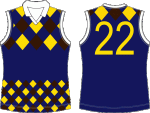 Up until 1950, they didn’t exist. When Hawthorn entered the VFL in 1925, they had a brown base with a gold vee and a club crest over the heart. The vee on the back is unnecessary, but it is a really nice jumper, with the crest adding a great touch.
Up until 1950, they didn’t exist. When Hawthorn entered the VFL in 1925, they had a brown base with a gold vee and a club crest over the heart. The vee on the back is unnecessary, but it is a really nice jumper, with the crest adding a great touch.
Worst home: The inverted original isn’t very nice, but those poos and wees stripes, they’re pretty ugly. Out of the VFL clubs, Hawthorn probably has the worst home jumper, but heck, it certainly doesn’t hold them back. Basically the biggest trouble with Hawthorn jumpers is how to put the numbers on the back. They flirted with brown squares, white numbers on stripes, white squares, all gold backs, and finally stripes up until halfway of the back. The worst has to be the brown square look from 1952.
Best away: In recent years, the Hawks introduced a reversal jumper, brown with gold on top and it isn’t as bad. There have been two variations, with a HFC letter logo and without, introduced this year. The without is better, just because the logo feels intrusive on the back.
Worst away: The 1997-98 away jumper was plain weird. It isn’t ghastly, but the cartoon gold hawk with a wing looks really strange. The white background clash jumpers are hard to pull off, and Hawthorn are still waiting to pull one off. The current clash jumper with a hawk swooping down isn’t great, but the 2008-11 look is worse.
Specials: Oh goodness me. There are some beauties in here. Let’s balance it out. The Indigenous jumper is quite nice, a good use of brown. The Kokoda jumper is not good, it was a really nice sentiment and I don’t want to quash the feeling, but it just looks bad. Hawthorn’s random 2005 heritage jumper, a blue look with red and white, a throwback to the original 1902 jumper is kinda great. The crazy lightning look is not good. The Hawks wore it – with sleeves! – until half time of it’s last game, when it was swapped for the sleeveless version because it was too hot. I wish I was making that up. It get’s worse, or better, I’m going with better. The official, worst jumper I have seen in the process of these two pieces. Say hello to the jockey outfit. It was worn once, in a pre-season game against Sydney and it’s so bad it’s beautiful. Whoever designed this bad boy deserves a knighthood for services against the Hawthorn Football Club.
Melbourne Demons
Best home: Melbourne have had a surprising amount of variations in their jumpers, at least until 1935. 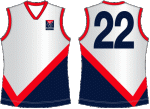 Originally, the Demons had a blue outfit with red lace. In 1919, a red vee was added that wasn’t filled in like it is now. The vee was pulled closer to the neck in 1925, and a band was added around the sternum in 1926. It was removed in 1930. The yoke has altered minimally over years, but that isn’t really important. 1998 brought a more standardized, modern look that is nice enough to take the crown.
Originally, the Demons had a blue outfit with red lace. In 1919, a red vee was added that wasn’t filled in like it is now. The vee was pulled closer to the neck in 1925, and a band was added around the sternum in 1926. It was removed in 1930. The yoke has altered minimally over years, but that isn’t really important. 1998 brought a more standardized, modern look that is nice enough to take the crown.
Worst home: The 1926 band is a little silly, and there haven’t been many good jumpers from 1975, when teams tried to be more colourful for the television. So that can be the worst.
Best away: Hmm. There aren’t a lot of good ones in here. The 2009 Demon chest on red was passable. But the two 2015 jumpers are pretty good. They involve a lettered logo on the chest, with a contrasting background. The red with blue lettering looks a little too much like a training jumper, and the white with blue lettering is good enough to be the best.
Worst away: The 2004, sneaky demon in the corner outfit wasn’t great. It always kind of reminded me of a pack of Redheads. From 2011-14 Melbourne went with an inverted clash jumper and it didn’t come off, but the 2008 silver outfit is a real stinker.
Specials: Melbourne’s heritage jumpers aren’t interesting, and their Indigenous jumper is a bit of a disappointment. The crest on the centre should have been replaced by some Indigenous artwork of some sort. One pre-season jumper from 2001-02 involved a kind of droopy yoke, I’m not sure why. For some comedy, in 2011 the printing came out too pink and had to be used for one week of pre-season, then shelved. Luckily, Melbourne have pulled off field of women jumpers. The pink-red swap is genius and both the 2010 and 2014 outfits are excellent.
North Melbourne Kangaroos
Best home: Before 1933, North Melbourne wore an all royal blue jumper with a white vee,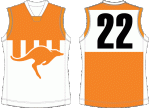 after 1976 North went to three blue stripes on a white background, and that is about it. In 2005 the three stripes were made thinner, which I think was a mistake. The thicker stripes look traditional, and the 1997 jumper had the best number font, so that’s the winner.
after 1976 North went to three blue stripes on a white background, and that is about it. In 2005 the three stripes were made thinner, which I think was a mistake. The thicker stripes look traditional, and the 1997 jumper had the best number font, so that’s the winner.
Worst home: Between 1959-72, the Kangaroos went with a thin striped look. It contained four stripes, with a collar and a number square. It is very busy, and the pin stripes on the front look silly. Thankfully, North moved on.
Best away: Why North would use any away jumper other than the original 1925 home jumper, I don’t know. It’s a solid opposite, it’s traditional and it looks good. They tried it in 2007-08 with a club logo in the middle and it worked well, more of the same please. The current reversed version of the home jumper is fine, but it doesn’t seem to be that much different to the home jumper if it is around for clash reasons.
Worst away: North have tried so hard to incorporate a leaping kangaroo on their away jumper but they haven’t really found a good one. They tried it in the late 90s and it didn’t really work, in 2003-04 they went for a blue and grey look, didn’t really work, and in 2005-06 they went for a kangaroo going across the side from front to back, didn’t really work. None of that is as bad as the ‘Argentina’ jumper. It’s a nice look for Argentina, for North it just looked soft.
Specials: North have tried to wear some kind of faded blue, wavy jumper in recent pre-seasons. It isn’t good, but the pre-season exists so clubs can try some new things. Their Indigenous jumper is quite good, the Kangaroos paw in the middle is a great touch to Australian history. Let’s be honest though, the bright orange, hi-vis promotional jumper from 2000 stunk. It wasn’t hard to spot Kangaroo players on the field that day, so there is a positive.
Port Adelaide Power
Best home: There is no doubt, the new jumpers are much better than the original look. The current jumper is on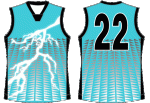 e of the best in the competition, it is intimidating, it is simple and the design works perfectly. It was designed by a 7 year old as part of a competition, and when it was worn it was such a success that Port asked the AFL permission to make it their official home jumper. I hope that kid got some royalties.
e of the best in the competition, it is intimidating, it is simple and the design works perfectly. It was designed by a 7 year old as part of a competition, and when it was worn it was such a success that Port asked the AFL permission to make it their official home jumper. I hope that kid got some royalties.
Worst home: You know where this is going. The original home jumper wasn’t any good. It’s easy to feel sorry for the Power here though, they have a great jumper in the SANFL and weren’t allowed to bring it across to the AFL. The original jumper tried to pay homage to that traditional look, but didn’t quite get it.
Best away: Yeah, current jumper. It’s a good reversal of a great jumper.
Worst away: Not good. Port tried a busier version of their home jumper for their first away jumper, which wasn’t great. They wore a High School basketball program style jumper against Collingwood in 2002 once, they tried a simple lightning look that didn’t come off, so they then tried a difficult actual lightning look, which was really cool in 2004 when I was ten years old, but isn’t cool now. That jumper needs to be struck by lightning and destroyed, if that would work, I don’t know what happens when lightning strikes polyester.
Specials: The current pre-season jumper is a teal backed version of the current home jumper, and it kind of sucks. Their heritage jumpers are always a delight though. The ‘prison bar’ look that Port Adelaide wears in the SANFL is a great jumper, and every time they get to wear it in the AFL is a win for the club. Their other heritage jumpers have been good too. A magenta type jumper that they wore in 2004 was really nice to wear once, as was their Geelong-style light blue hoops that they sported in 2005. Once they get around that original jumper, Port Adelaide have some really great looks.
Richmond Tigers
Best home: There’s a surprising amount of early variance here. In 1914, Richmond 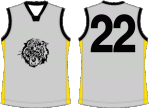 adopted the sash and before that they went through a string of random patterns, all with the yellow and black colour palette. There’s more on that later, but from 1914, the sash has only been swapped, thickened and removed (later restored) from the back of the jumper. The nice wide numbers that appeared half way through 2005 are the easiest to read and the best jumper.
adopted the sash and before that they went through a string of random patterns, all with the yellow and black colour palette. There’s more on that later, but from 1914, the sash has only been swapped, thickened and removed (later restored) from the back of the jumper. The nice wide numbers that appeared half way through 2005 are the easiest to read and the best jumper.
Worst home: Those early jumpers, while interesting, weren’t great. In 1910 the Tigers went for a thin stripe across the sternum and widened it in 1912. These kind of jumpers were kind of popular at the time, but they are pretty useless. There is no wonder none of the plain striped jumpers survived, only the Western Bulldogs have kept a similar look. The worst belongs to the Hawthorn style, vertical stripes from 1908, with the stripes looking kind of thick and ghastly, like Vegemite themed window shutters.
Best away: I’m not sure any of these jumpers deserve to be the best, but there must be a winner. I guess the more yellow of 2014 was a kind of suitable clash jumper? Maybe?
Worst away: I think the 2015, reversed clash jumper makes complete sense. It is definitely opposite to the home jumper. But I don’t think it looks good. Yellow is a colour you have to keep minimum, or give it the whole outfit. A black sash halfway through isn’t good on a yellow jumper.
Specials: Richmond wore a more Hawthorn-style thin vertical striped jumper in 2008 for the centenary of their club, and a red and yellow vertical striped jumper in 1978 for the Willis Cup, to avoid clashing with Glenelg. Richmond’s pre-season jumpers have been pretty useless. They’ve tried three different claw marked jumpers, between 1998-03 (with a year off in 1999, perhaps to redesign the jumper and come back with the same one), a yellow-backed version in 2007-08 and more of a tearing claw in 2009-10. Claw jumpers never work. Really, they don’t. They also tried two waved jumpers, in 2011 and 2012, they weren’t a disaster but they weren’t good. There was also the infamous Silver Top Taxis jumper RIchmond tried out. That was worth a laugh, and I’m sure the Tigers got a fair pay packet out of it too. However, Richmond have tried four different Indigenous jumpers, and they have all been pretty good. The secret may be that they incorporated the Aboriginal artwork into the existing jumper. It worked well in 2011, 2012, 2013 and 2014. However, the 2014 look might be the weakest.
South Melbourne Swans
Best home: South Melbourne cycled through several styles of red and white before they settled on their red vee.  Between 1920-22, South tried a Carlton-style, all red with a club insignia on it and it was actually great. The red vee is the best though, vees are always great, and after 1977 the vee was perfected to be very straight.
Between 1920-22, South tried a Carlton-style, all red with a club insignia on it and it was actually great. The red vee is the best though, vees are always great, and after 1977 the vee was perfected to be very straight.
Worst home: When the VFL was formed, South wore a horizontal red and white look, that isn’t truly awful, but it just doesn’t look right. In 1907, they tried a red sash, Essendon-Richmond style, that also was terrible, but must have been a real pain to wash. The worst though was a red braces style look they wore between 1905-06, but even that isn’t completely horrible. Red and white makes a good combination, so these jumpers aren’t completely terrible.
Specials: South Melbourne didn’t have any away jumpers, and only one special jumper: this YMCA-looking orange clash jumper when they played South Fremantle in the 1979 Escort Cup. It’s pretty average, and I’m not sure where they found them, but there probably weren’t a large array of options.
St Kilda Saints
Best home: For seven years, between 1915 and 1922, St Kilda substituted yellow for white  in their traditional red, white and black striped look because their colour scheme was the same as Germany’s. In 1919 this resulted in a yellow vee look that actually wasn’t bad. It’s not the best home jumper though, the traditional, three panel look is the best, there is no doubt. The 1983-96 jumper is a perfect embodiment of that look.
in their traditional red, white and black striped look because their colour scheme was the same as Germany’s. In 1919 this resulted in a yellow vee look that actually wasn’t bad. It’s not the best home jumper though, the traditional, three panel look is the best, there is no doubt. The 1983-96 jumper is a perfect embodiment of that look.
Worst home: For some reason, St Kilda decided to step outside of history for four years (starting in 1997) to go with a black cross, largely red jumper. This would have a been a solid away jumper with it’s contrast and look, but it should never have been a home jumper.
Best away: When the bad home jumper came into existence, St Kilda’s traditional jumper became their away jumper, so I guess that technically has to be the best away jumper. Outside of that, St Kilda have had a couple nice looks in this decade. Coinciding with a thinning of the white stripe on the home jumper, St Kilda adopted a thickened white stripe in 2009-10 for their away jumper and it is quite smart and sharp. Between 2011-14, the Saints turned that thickened white into a cross and that was a really classy looking guernsey.
Worst away: The thin stripes from 2004-06 was extremely forgettable and the 2007-08 clash jumper was too much like a training jumper. But the star of this show is the Pura Light Start yellow jumper, or the yellow peril. This was fantastic, I only hope Pura paid St Kilda bucketloads of money to wear this jumper, because there is not other explanation for it. A genuine classic.
Specials: The 2014 pre-season, stickman jumper was great. The Saints used it often at training and it may be the best training jumper in the league. Long live the stickman. The Saints have worn a couple jumpers for their New Zealand games, a hammerhead shark/stingray design – I’m not sure where the shark and the stingray are, but I haven’t studied Maori artwork – that was pretty good, and a nice, sword style white strip, with some cool artwork adorning the jumper. St Kilda’s Indigenous jumper was also reasonable, incorporating the original design well, while also stepping out quite smartly. In 2013, St Kilda celebrated 140 years of the club with it’s 1873 jumper, a red and black horizontal stripe that included scripture of every player that played at least five games. It was a solid change up, so St Kilda have a great track record on special jumpers.
Sydney Swans
Best home: When the Swans moved to Sydney they kept their red vee until 1987 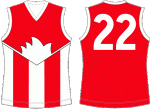 when the Sydney Opera House shadow was added. It’s a great addition. The only real change to the jumper since then change to an all red back and a wider yoke in 1992. The SMFC initials were added to the neck of the jumper in 2004 and I always enjoy those touches. With the traditional, V shaped collar, that 2004 jumper takes the award.
when the Sydney Opera House shadow was added. It’s a great addition. The only real change to the jumper since then change to an all red back and a wider yoke in 1992. The SMFC initials were added to the neck of the jumper in 2004 and I always enjoy those touches. With the traditional, V shaped collar, that 2004 jumper takes the award.
Worst home: While the white back is always enjoyable to see on the Warwick Capper highlight tapes, it isn’t as smooth as the all red back. The thinner red on the 1989-91 jumper was the worst.
Best away: Sydney are lucky in that until Gold Coast arrived, no other team really clashed with them. To avoid a clash with the Suns, the Swans just switch to a white back and they are fine, which keeps their away jumper in a grounded, stylish look. In 2015, Sydney have added an “EST. 1874” to the inside of the collar and as I mentioned, I like those touches.
Worst away: In 2010, Sydney sported a South Melbourne style vee on their jumper, with a club logo in the middle of it. On any other team, this would probably be the best away jumper, but Sydney’s only other look was mentioned above and it is better, so the 2010 look is the worst.
Specials: The 1996 throwback to 1905-06 braces was an improvement and the 2009 celebration of the 1909 jumper was also an improvement on the original. Sydney’s sole pre-season jumper was worn between 1997 and 98 and contained some horrible combination of the braces and the Sydney Opera House style and it was pretty darn bad. In 2003, Sydney wore a team of the century celebration jumper, with a logo reading 1874-2003, so I’m not sure what century that team was picked from, but it was okay. They also went with a horizontal red and white jumper to celebrate QBE lasting 125 years in the financial game, so well done QBE. The Swans wore a really bizarre Indigenous jumper, with what looked like Easter Eggs on the front, I’m not sure what that design was, I’m sure it has some traditional roots though.
West Coast Eagles
Best home: West Coast’s blue and yellow outfits have squandered potential to be great jumpers. 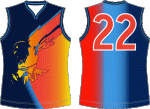 The Eagles wore a curtain-opening style for the first decade and a bit and while it was unique, it was a little odd. The eagle head that West Coast sported in that time was a strange outline, yet it was better than the current eagle they sport. The current jumpers aren’t bad, but they are uninspiring. The light blue look in the late 80s and early 90s was probably the best they sported.
The Eagles wore a curtain-opening style for the first decade and a bit and while it was unique, it was a little odd. The eagle head that West Coast sported in that time was a strange outline, yet it was better than the current eagle they sport. The current jumpers aren’t bad, but they are uninspiring. The light blue look in the late 80s and early 90s was probably the best they sported.
Worst home: The original yellow back, blue shapes look was pretty average. The flying eagle from 2000-06 was terrible though, West Coast tried to get some funky colour schemes during this time and they didn’t work out.
Best away: The new eagle, old jumper look West Coast sported between 2003 and 2011 was actually a great combination. That smaller eagle is more suitable than the big one of the current home jumpers and looks sharper than the outlined yellow eagle of the original home jumpers.The current blue away jumpers, with the refined yellow shoulders and the weird eagle aren’t as good but they are passable.
Worst away: The current clash jumpers are forgettable, not offensive, but forgettable. But this section is all about the rainbow vomit that West Coast wore in 2000-02 that is just hilarious now. Where that orange/red fade came from is a mystery, the bright baby blue on the centre of the back doesn’t make sense, and why it has all been computerized together in some kind of fade is just ridiculous. A hall of fame jumper.
Specials: On the 30th anniversary of Western Australia’s stunning 1977 victory over Victoria, West Coast wore a replica jumper with the team on the back, it’s a yellow back with a black sash and it isn’t all that bad. The Eagles wore a terrific Indigenous jumper last season, with great artwork of an eagle on the centre of the jumper. West Coast have worn only one pre-season only jumper, with a weird digital design of an eagle head on the front that was a strange look. Perhaps they were trying to see whether it could work as a home jumper, but it was weird. The Eagles have also worn a 25 year anniversary scripture jumper with the names of every Eagles player on it, and a 20 year anniversary guernsey to celebrate the 1992 premiership with the team listed on it. Highly forgettable, both of them.
There you go then, thanks for sticking through all of this and I hope your team was treated properly. If you didn’t check out part one, you can here. If you want to know the top five worst jumpers of all time, click right here.
